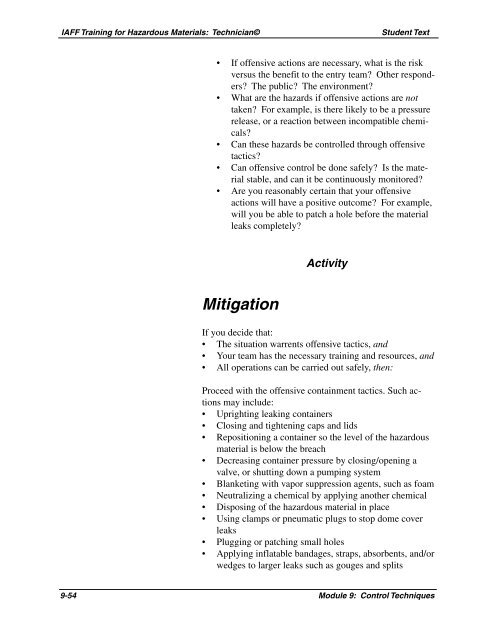Module 9: Control Techniques - International Association of Fire ...
Module 9: Control Techniques - International Association of Fire ...
Module 9: Control Techniques - International Association of Fire ...
You also want an ePaper? Increase the reach of your titles
YUMPU automatically turns print PDFs into web optimized ePapers that Google loves.
IAFF Training for Hazardous Materials: Technician©<br />
Student Text<br />
• If <strong>of</strong>fensive actions are necessary, what is the risk<br />
versus the benefit to the entry team? Other responders?<br />
The public? The environment?<br />
• What are the hazards if <strong>of</strong>fensive actions are not<br />
taken? For example, is there likely to be a pressure<br />
release, or a reaction between incompatible chemicals?<br />
• Can these hazards be controlled through <strong>of</strong>fensive<br />
tactics?<br />
• Can <strong>of</strong>fensive control be done safely? Is the material<br />
stable, and can it be continuously monitored?<br />
• Are you reasonably certain that your <strong>of</strong>fensive<br />
actions will have a positive outcome? For example,<br />
will you be able to patch a hole before the material<br />
leaks completely?<br />
Activity<br />
Mitigation<br />
If you decide that:<br />
• The situation warrents <strong>of</strong>fensive tactics, and<br />
• Your team has the necessary training and resources, and<br />
• All operations can be carried out safely, then:<br />
Proceed with the <strong>of</strong>fensive containment tactics. Such actions<br />
may include:<br />
• Uprighting leaking containers<br />
• Closing and tightening caps and lids<br />
• Repositioning a container so the level <strong>of</strong> the hazardous<br />
material is below the breach<br />
• Decreasing container pressure by closing/opening a<br />
valve, or shutting down a pumping system<br />
• Blanketing with vapor suppression agents, such as foam<br />
• Neutralizing a chemical by applying another chemical<br />
• Disposing <strong>of</strong> the hazardous material in place<br />
• Using clamps or pneumatic plugs to stop dome cover<br />
leaks<br />
• Plugging or patching small holes<br />
• Applying inflatable bandages, straps, absorbents, and/or<br />
wedges to larger leaks such as gouges and splits<br />
9-54 <strong>Module</strong> 9: <strong>Control</strong> <strong>Techniques</strong>
















